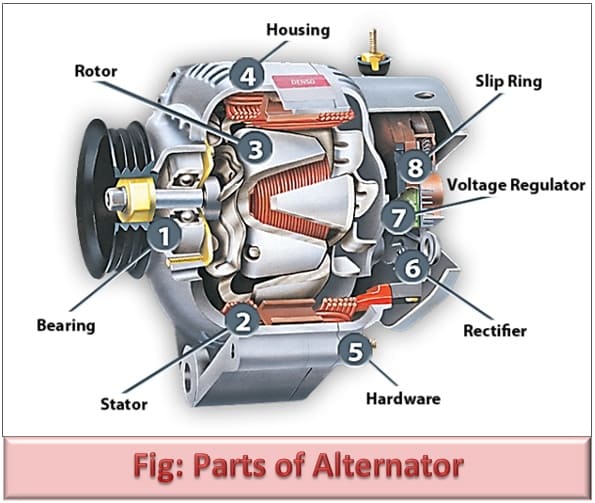Parts of Alternator:
Alternator is an electrical machine which generate alternating voltage. The operation is based on the principle of electromagnetic induction. It is essential for the generation of current is the relative motion between the field magnet and the armature winding.
In an alternator, the armature winding is kept in the stator slots and made stationary and the field magnet is made rotating surrounding the armature winding by means of a prime mover and produces the desired Magnetic Flux. The field magnets are excited by an external DC source and joined to the source of supply through slip rings. The induced alternating voltage is received from the armature winding via a slip ring and is sent to the load by means of carbon brushes.

As the field magnets are rotating, so the polarities of the magnet are changed alternately and they induce alternating emf to the stator and the direction can be found out with aid of Fleming’s right-hand rule.
Alternator Rotor Types:
The Rooter of an Alternator are of two types:
- Salient pole type or projecting pole type
- Non-Salient pole type or smooth cylindrical type
Salient pole rotor:
This type of rotor are low and medium-speed alternator which are driven by water turbines or diesel engines. Normally, the speed of this type of rotor varies from 120 rpm to 400 rpm. This type of rotor has a larger diameter but a small axial length.
Non-salient pole rotor:
The Non-Salient pole type of rotor is suitable for high-speed alternators which are driven by steam turbines. The speed of the non-salient type rotor varies from 1500 rpm to 3000 rpm. This type of rotor has a smaller diameter but has larger axial length.
Use of Alternator:
The alternators are used in the following places:
i. In the power stations for the generation of electrical power.
ii. As a power supply purpose in domestic loads & commercial loads.
iii. To meet up the peak loads and standby loads using Gas turbines or diesel engines as a prime mover.
iv. In large aircraft and ships for lighting loads and other purposes.